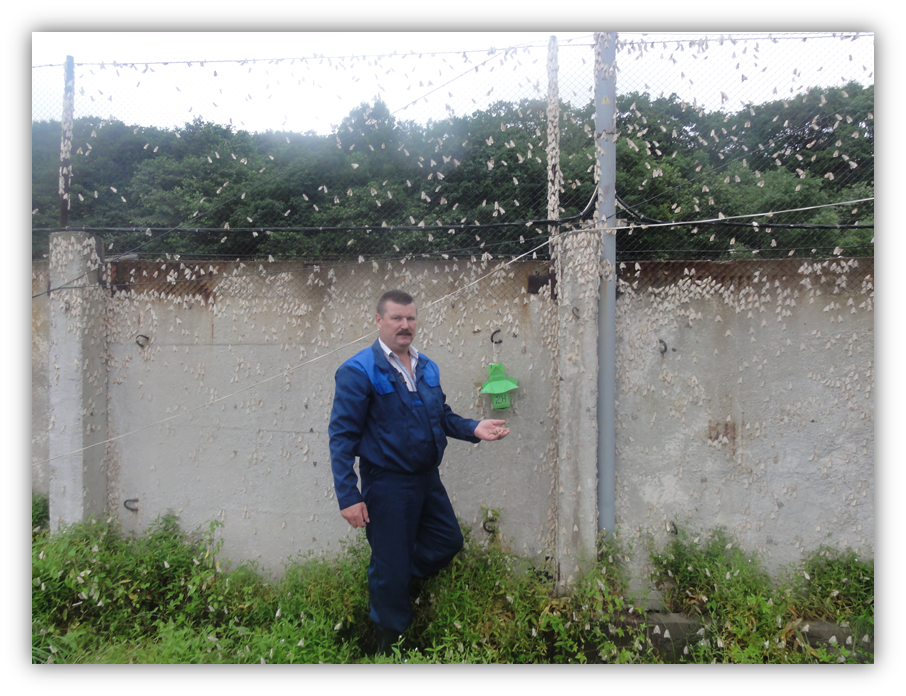There are no known permanently established populations of Asian spongy moth (Lymantria dispar asiatica) in North America– but in order to keep the continent free of this pest, it is critical for forest health professionals to learn about its current status.
Recent reports from USDA APHIS and US Customs and Border Protection indicate that Asian spongy moth populations are in a general cyclical upswing in their native range of Russia and Japan. This means that the chance that this moth is accidentally brought to North America on shipping container surfaces is higher than usual- which in turn means that Western port communities need to be on high alert.
“Asian Spongy Moth activity was anticipated to be high at the beginning of the 2014 season, and is anticipated to be yet higher in 2015. At this point we have seen high populations in both Russia and Japan. USDA APHIS is receiving regular reports from these countries to monitor the situation. The busy season for AGM is from June through September, and at this point in the 2014 season Customs and Border Protection has inspected approximately 1600 vessels and found four vessels in US ports with positive AGM egg masses – all from Japanese ports of origin. The Japanese inspection companies have had removed adult moths or egg masses from 82 ships in 44 different Japanese ports during pre-departure procedures. The success rate of the inspection companies in Japan, for ships bound for North America, is over 99%.” William Wesela, Asian spongy Moth Program Director, USDA APHIS PPQ.
Knowing that these egg masses are making it to North American ports, even if extremely rarely, underscores the high importance of looking for and reporting possible individual moths, egg cases, or infestations of any spongy moths outside of the known infested area in Eastern US and Canada (official map here) – especially in Western port cities. Spongy moths (of both the Asian and European types) can be and have been eradicated when found in isolated infestations, and the key to eradication is rapid detection of each isolated new spongy moth population. While the Asian spongy moth looks incredibly similar to the European spongy moth, it is different because of two key aspects: the wider range of tree species it can destroy, and the female adult moths can fly (unlike the European spongy moth, whose females are flightless). This makes detecting potential infestations of Asian spongy moth incredibly important to the health of North American trees.

Russian official observing Asian spongy moth trap with high local moth densities in Olga, Russia. Credit: USDA APHIS PPQ (ed. note: all the white specks are individual Asian spongy moths)
One of the most important tenets of Don’t Move Firewood is to be proactive with precaution. We often get questions on our e-hotline like “Can I move some seasoned old firewood? Any bugs must be long gone, right?” and our response is always the same “No, please don’t, it might harbor pests like spongy moths.” Spongy moths, in particular, can infest firewood or lumber scraps regardless of how long the wood was aged– and their egg cases can look very much like an otherwise innocent little patch of mold.
Western North American port communities, especially those receiving a lot of shipments from Japan and Russia (such as Long Beach, Seattle, Portland, and Vancouver), need to include Asian spongy moth in their forest pest outreach programs and materials. Teaching the public about the importance of looking for spongy moths, and not moving firewood, is critical to finding pests like these early enough to launch a successful eradication program. Just because you don’t have a recorded quarantine does NOT mean that you might not have a small unknown infestation in your community.
Here are resources on the topics of Asian Spongy Moth and European Spongy Moth
- Asian Spongy Moth fact sheet, USDA APHIS from April 2014
- Asian Spongy Moth official USDA APHIS information page
- Short public education video on European spongy moth: well suited to be used in Asian spongy moth education, with a brief caveat or discussion on species differences
- Don’t Move Firewood’s Gallery of Pests page on Asian Spongy Moth
- US Customs and Border Protection news release on Asian Spongy Moth interception, 2013
- Your Move Spongy Moth Free, European spongy moth educational website from HungryPests, an initiative of USDA-APHIS
- Map of European spongy moth quarantine for North America



